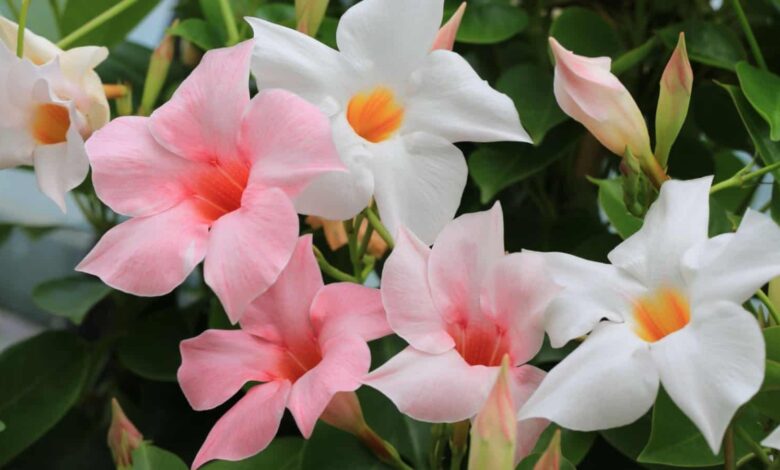A Complete Guide to Growing and Caring for Mandevilla: The Tropical Beauty?

Mandevilla is a stunning, tropical flowering plant renowned for its vibrant blooms and lush foliage. Its large, trumpet-shaped flowers come in various colours, from classic pinks and reds to softer whites and yellows, making it a popular choice for adding colour to gardens, patios, and balconies. This guide provides everything you need about care, from planting to nurturing this beautiful plant in various climates.
What is Mandevilla?
Mandevilla, also known as Dipladenia in some varieties, is a tropical and subtropical flowering vine native to South and Central America. It belongs to the Apocynaceae family and is well-loved for its showy flowers and glossy, dark green leaves. It can be grown in containers, garden beds, or hanging baskets and is often trained on trellises or other supports for a spectacular vertical display.
Why Choose Mandevilla for Your Garden?
It is perfect for adding an exotic touch to your outdoor space. Here are some reasons why gardeners love Mandevilla:
- Long Blooming Season: Mandevilla blooms from spring through late autumn, providing long-lasting colour.
- Versatile Growing Options: It can be grown as a climbing vine, in pots, or as a ground cover.
- Low Maintenance: While it needs the right conditions, it is relatively easy to care for once established.
- Attracts Pollinators: Its bright, trumpet-shaped flowers attract hummingbirds and butterflies.
Types of Mandevilla
There are several popular varieties of each with unique characteristics:
- Mandevilla sanderi (Brazilian Jasmine): Known for its large, pink flowers and vigorous climbing ability.
- Mandevilla boliviensis (White Mandevilla): Produces stunning white flowers with a yellow throat, often grown as a bushy shrub.
- Mandevilla laxa (Chilean Jasmine): Fragrant with white flowers, this variety is more tolerant of cooler temperatures.
- Dipladenia (a close relative): This has a more compact, bush-like form and is often called a “bush mandevilla.”
How to Plant Mandevilla
- Choosing the Right Location
Mandevilla thrives in warm, sunny conditions. Here’s how to choose the best spot:
- Sunlight prefers full sun, ideally 6-8 hours of direct sunlight daily. Partial shade can be tolerated, but flowering may be less abundant.
- Temperature: is frost-sensitive and should be grown outdoors only in USDA zones 10-11. In cooler climates, it can be brought indoors during winter.
- Soil Requirements
Mandevilla requires well-draining, slightly acidic soil with good organic content. To prepare the soil:
- Use a mix of garden soil and compost to enhance nutrients.
- Add perlite or sand to improve drainage.
- Aim for a soil pH of 6.0 to 6.5 for optimal growth.
- Planting Process
Whether planting in the ground or a container, here’s the process:
- In-ground planting: Dig a hole slightly larger than the root ball, set the plant in, and fill in with soil. Water thoroughly.
- Container planting: Choose a container with drainage holes, fill it with a quality potting mix, and plant Mandevilla with the root ball level with the soil surface. Ensure it has enough room to grow.
How to Care for Mandevilla
- Watering
Mandevilla requires regular watering to moisten the soil but prefers soggy conditions. Here’s what to consider:
- Frequency: Water deeply once or twice a week, depending on the weather. In hot climates, more frequent watering may be needed.
- Humidity: Since it’s a tropical plant, it enjoys higher humidity. You can mist the leaves occasionally, especially indoors, to increase moisture.
- Fertilizing
Fertilization is essential for lush foliage and abundant flowering. Use a balanced fertilizer to provide the necessary nutrients:
- Frequency: Feed Mandevilla every 2-4 weeks during the growing season (spring and summer).
- Type: A liquid fertilizer high in phosphorus (10-20-10) promotes blooming. Avoid excessive nitrogen, as it encourages leaf growth over flowers.
- Pruning
Pruning is vital for keeping the Mandevilla healthy and ensuring it maintains a desirable shape:
- When to Prune: Prune in early spring before new growth begins. This will encourage a bushier, fuller plant.
- How to Prune: Trim back any leggy or overly long vines. Dead or damaged leaves should also be removed regularly to prevent disease.
- Supporting the Vines
If growing Mandevilla as a climbing vine, it will need some support to help it grow vertically:
- Trellises and Stakes: Provide a trellis, stakes, or another structure for the plant to climb on.
- Training: Tie the vines gently to the support structure as they grow, guiding them to create a balanced look.
Common Problems and Solutions
are generally resilient but can experience pests, diseases, or poor growing conditions.
- Pests
- Aphids and Whiteflies: These pests can feed on the leaves, causing yellowing and stunted growth. Use insecticidal soap or neem oil for control.
- Spider Mites: These tiny pests thrive in dry conditions. Mist the plant regularly or introduce predatory mites to control infestations.
- Diseases
- Powdery Mildew: White, powdery spots on leaves may indicate powdery mildew. Improve air circulation and avoid overwatering.
- Root Rot: Overwatering or poorly draining soil can lead to root rot. Ensure good drainage and allow the soil to dry between waterings.
- Nutrient Deficiencies
- Yellow Leaves: Yellowing leaves can signal a lack of nitrogen. Apply a balanced fertilizer and ensure the soil pH is appropriate.
- Lack of Blooms: If your isn’t flowering, it may need more sunlight or a phosphorus-rich fertilizer.
Growing Mandevilla Indoors
Mandevilla can be grown indoors during winter or as a houseplant year-round in colder climates. Here’s what you need to know:
Light and Temperature
Place the plant near a sunny window, ideally with 6-8 hours of indirect sunlight daily. Keep it in a room where temperatures stay between 60-75°F (15-24°C).
Watering and Humidity
Indoor Mandevilla requires less water than outdoor plants. Water when the top inch of soil is dry. To increase humidity, mist the plant regularly or place it on a pebble tray filled with water.
Fertilization
During the indoor growing season, reduce fertilization. Feed monthly with a balanced liquid fertilizer to keep the plant healthy.
Propagating Mandevilla
Mandevilla can be propagated through cuttings, making it easy to create new plants:
- Select a Cutting: Take a 4-6 inch cutting from a healthy vine in spring or early summer.
- Prepare the Cutting: Remove the lower leaves and dip the cut end in the rooting hormone.
- Plant in Soil: Place the cutting in a pot filled with moist, well-draining soil and cover it with plastic to retain moisture.
- Transplant: After 6-8 weeks, the cutting can be transplanted to a larger container or garden bed once the roots are established.
Winter Care for Mandevilla
For gardeners in colder regions, Mandevilla needs special care to survive the winter:
- Bring Indoors: Before the first frost, bring the plant indoors or to a sheltered area.
- Reduce Watering: Water sparingly during winter as the plant enters dormancy.
- Limit Fertilizer: Suspend fertilization until spring, when new growth resumes.
Conclusion
Mandevilla is a captivating addition to any garden or home, offering months of breathtaking blooms with relatively low maintenance. By understanding its needs for sunlight, water, and support, you can cultivate a healthy that brings beauty and a touch of the tropics to your space. Whether growing it outdoors or nurturing it indoors over winter, vibrant flowers will brighten any setting. With the proper care, this tropical plant will reward you with abundant, colourful blooms season after season.





